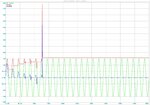Follow along with the video below to see how to install our site as a web app on your home screen.
Note: This feature may not be available in some browsers.
Yes, it isn't a completely powerless dropper but far more efficient than a resistor in most cases. Substitute Xc for R to calculate the value you need.
Words of caution though:
1. The value of Xc depends on the frequency. Xc = 1/(2*pi*f*C).
2. If it fails short circuit the full voltage appears at the load.
3. Unless you have some DC present, you must use a non-polarized capacitor.
4. If you disconnect the source or the load, the capacitor might retain charge.
5. If you are using it as an AC line dropper it provides no isolation barrier could be extremely dangerous.
6. If you are using it as an Ac line dropper you must draw equally on positive and negative half cycles or it will simply charge up.
Brian.
Yes, it isn't a completely powerless dropper...
An ideal capacitor does not dissipate any power. If there is a DC component present, that part will be blocked fully.
Most resistors fail as open circuit and so do some capacitors. I think capacitors used for PF corrections fail in the open circuit mode.
You can use a capacitor with AC input and a half wave rectifier; it will not be most efficient but it will work (because half wave rectified is equal to a DC plus AC and the capacitor will block the DC and pass the AC).
I disagree that it will work in a conventional half wave rectification circuit, ...
Just for fun, I just tried a simulation (310V AC in series with a 100R in series with a 1uF cap in series with a 10K resistor) and I see AC current flowing through the capacitor. Did I do some mistake?
Here it is: you can simulate it in any simulator of your choice:View attachment 152856
ok, Screenshot of result please. Also which simulator did you use?

Here it is: you can simulate it in any simulator of your choice:View attachment 152856
Please reconsider. A least one diode missing, as already explained by betwixt.